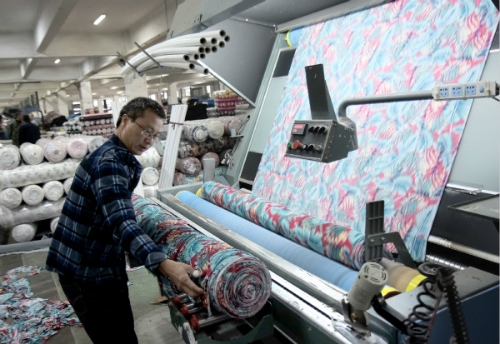Textile firms weave success despite pandemic
A buyer selects fabric at Zhejiang ESSE Textile Technology Co Ltd in Shaoxing, Zhejiang province, on Nov 25. [Photo by Xiao Da/China Daily]
Orders are risng for Chinese companies due to production delays in some countries. The sharp increase in trade orders has two drivers.
First, the global online shopping carnival known as Singles Day held from Nov 1 to Nov 11 this year and created by Alibaba Group generated a lot of interest. Second, large numbers of orders were transferred from India to China due to India's severe COVID-19 situation, Sun said.
In October, China's textile exports reached $11.66 billion, with a year-on-year growth of 15.9 percent, according to the General Administration of Customs.
Apparel exports stood at $13.18 billion, a year-on-year growth of 6.8 percent, while export growth continued to increase 0.3 percentage point compared with September, maintaining three consecutive months of positive growth.
"Since the second quarter, production, exports and circulation have gradually resumed due to the gradual control of COVID-19 in China," said Sun Huaibin, vice-chairman of the China National Textile and Apparel Council, who added that in addition, digitalization and intelligentization also continuously improved production efficiency and reduced costs.
The same situation happened at Senru Textile Co Ltd in Keqiao district, Shaoxing, Zhejiang province. The company mainly produces knitted fabrics such as cashmere, wool and flannel.
Large numbers of factories in India and Bangladesh have been unable to resume production due to the severe pandemic situation. Therefore, orders were being transferred to China, according to a Senru official, who added that since the beginning of October, export orders began to surge even as the price of raw materials went up daily.
"Most of the additional orders came from Europe and the United States as well as Japan and South Korea. From June to September in previous years, we exported on average one container per day. This year, the export volume dropped sharply before September due to COVID-19. But now export orders have recovered to 70 percent of previous-year levels."
From January to October, the output value of Keqiao district's textile industry reached 83.04 billion yuan ($12.6 billion), accounting for 52.5 percent of the district's total industrial output value. The printing and dyeing industry achieved an output value of 32.3 billion yuan, with a year-on-year growth of 2.1 percent, 2.4 percentage points higher than the district's average, according to a recent report from Hangzhou Daily.
An employee wraps fabric at Zhejiang ESSE Textile Technology Co Ltd in Shaoxing, Zhejiang province, on Nov 25. [Photo by Xiao Da/China Daily]
Since September, many large export-oriented textile enterprises in India, Bangladesh, Vietnam and other Asian nations reportedly failed to guarantee normal delivery due to the pandemic, while European and US retailers shifted many orders originally meant for these countries to China in a bid to ensure supplies during the holiday shopping seasons.
In addition, as production stagnated in most other countries due to the ongoing severe pandemic, the scale of China's exports increased sharply, driving up the cost of containers and port freight.
"The volume of foreign trade orders has seen an increase since May, and has basically recovered to the level of last year since the beginning of June, despite the damage inflicted by the pandemic," said Yan Liangmin, general manager of Zehao Textile Co Ltd in Keqiao.
"The major difficulty confronting us now is rising ocean freight costs due to the increasing demand for transport because of China's booming export volume and the poor circulation of containers caused by the pandemic," Yan said.
Freight rates for European routes, Persian Gulf routes, South American routes and other international routes have all increased since June. In October, container throughput at China's eight key hub ports rose 11.1 percent year-on-year, the highest in nearly 10 months, said the China Ports and Harbors Association.
The pandemic has had a severe impact on both supply chains and demand, said Li Xingqian, director of the foreign trade department at the Ministry of Commerce.
China is the world's largest textile producer and exporter with advantages in the export of labor intensive products. Since remarkable progress has been made in coordinating epidemic prevention and control to promote economic and social development, China has taken the lead in resuming work and production, effectively guaranteeing supplies for the international market and supporting the smooth operation of international industrial and supply chains, added Li.
Since May, orders for Chinese fabrics and raw materials for textiles have increased by more than 100 percent. Clothing industry orders have undergone a year-on-year increase of more than 200 percent, quadrupling in July, said Alibaba.com, the business-to-business online marketplace run by Chinese e-commerce giant Alibaba Group.

